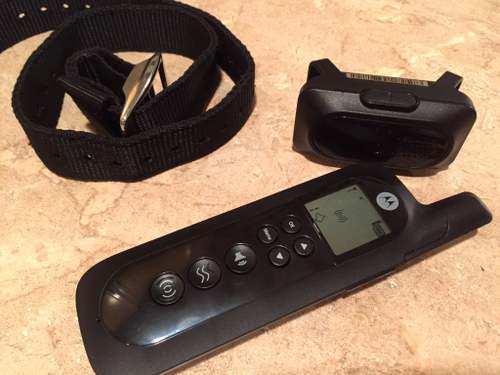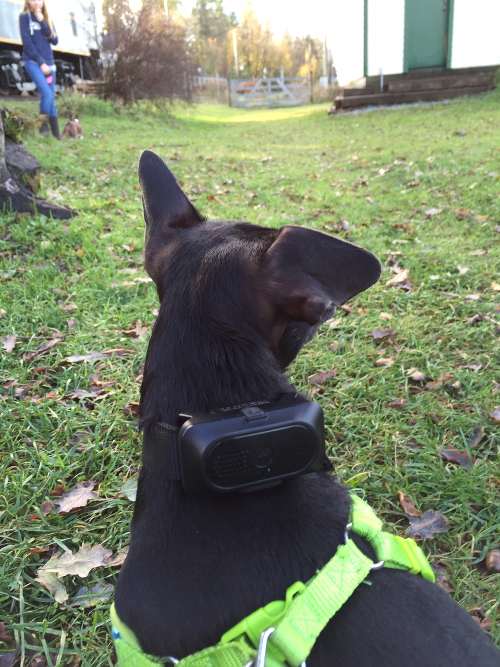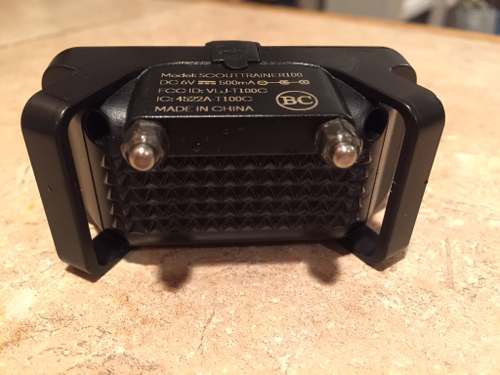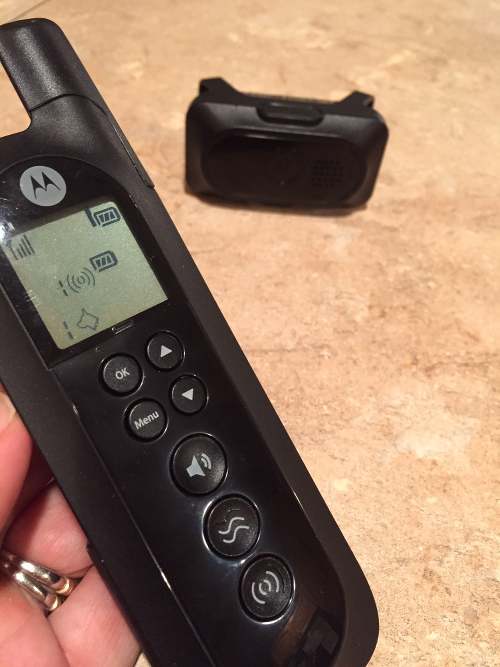 This is Polly.
This is Polly.
She’s cute isn’t she? Polly is a dachshund/Chihuahua cross, also known as a Doxie. I’d share how old she is, but other than a ballpark between 1 and 2, I really have no idea. What I do know is that Polly was one of hundreds of dogs living in a small, cramped shelter, and because she’s black, she was one of the next up to be put down. When a local rescue association asked me if I’d adopt a dog, I said yes and adopted her sight unseen.
We’ve had her for six months now, and I’ve learnt that because Polly is a rescue dog, she has some unique ‘quirks’ that set her apart from our other dog Cleo. Cleo’s a neurotic Boston Terrier, and I’ll get to her in a bit because this is about her too.
Polly’s quirks include going outside to the bathroom and appearing to actually go, then coming inside and sneaking away to do her business on the carpet somewhere else. I’ve almost got that one handled, thank goodness, although she does sneak one on me once in awhile. Polly will also hop up on the bench at the table and use her puppy eyes to try to join us for our evening meal. I’ve never been a fan of that, but she now listens when I tell her to go to her basket and lie down.
But there’s one issue Polly has I needed to fix and fix fast, simply because if I didn’t it would be extremely likely she’d be hit by a car. Polly is a sprinter. When we’d open the door at our house, Polly would sprint straight out the door and run into the driveway. If someone was there, a delivery guy or the neighbor, she’d stop and roll over onto her back looking for rubs. It’s adorable when it happens in a safe environment – unfortunately outside isn’t that safe.
She’s sprinted out the door and straight into the street before because she saw someone walking their dogs. That time she narrowly missed being run over by a car driving by. Other times she’s sprinted down the street and around the corner, which of course means I’m chasing her and trying to get her to come home. And before you think that it’s easy to catch a small, black wiener dog, think again – Polly is faster than I am, and she’s hard to catch.
That’s why I was pretty excited to test out the Motorola Scout Trainer 100. It’s a remote trainer system, and it’s something that’s somewhat new to the pet market. But after using it for a few weeks, I’m pretty sure busy pet owners are going to like it over traditional training classes. Why? In a nutshell, it works.
Here’s a look at the features on the Motorola Scout Trainer 100

- Solves common dog issues by reinforcing basic training commands
- Has three levels of correction – warning tone, gentle vibration, and 15 levels of static correction from mild to painful
- Collar synchs with remote control quickly and easily
- Remote control and collar also work as a walkie talkie so you can be a voice in your dog’s ear
- Packaged with contacts for dogs with less of a coat or those who are extra furry
- Includes an adjustable collar
 Getting ready to use the collar
Getting ready to use the collar
Polly is a small dog, so when I was unpacking the Motorola Scout I realized that the collar was very, very big. She’s an extra small on a good day, so I was glad that the collar had several holes to adjust for size and you can cut off the extra strap.
The collar also comes with several metal contacts. They look like small nails and you choose your size depending on your dog’s coat. My dog has a very short coat, so changing the metal contacts wasn’t necessary.
To use the Scout trainer, just take the pet collar unit and turn it on, then hit the pair key and wait for the remote control unit to detect the pet collar. You’ll see a message on the LCD screen indicating your device is paired. If you have more than one pet, you can have multiple collars hooked up to your remote control unit. I used the same collar for both dogs.
The most important thing to remember when using a training collar is you have it fitted on your dog’s neck properly. I wasn’t planning on using the static correction with my dogs, or using only a very mild static correction, but I still had to have it perfectly adjusted to their necks. Polly also has a huge roll of skin under her neck, so I placed the collar at the back of her neck instead of underneath. With Cleo, I put it underneath her neck.
I did notice in the booklet that came along with the Motorola Scout said not to put the collar off to the side, but it worked for me. Every dog is different, so you’ll have to experiment to find the perfect position for your dog.
Begin training 
Once your collar is on and adjusted to your dog’s neck, you can begin training. With Polly, my main goal was to get her to stay. By having her understand stay, I’d stop her from running out the door and potentially injuring herself in our street.
Before I got started, I bought a huge bag of small dog treats. Positive reinforcement when training a dog is just as important as correction, so I had the treats to say ‘Good Dog!’ and the collar to let her know when she hasn’t made the right choice.
The type of correction you use is up to you, and that’s the beauty of the Motorola Scout. Unlike a ‘shock’ collar, you can choose what type of correction you want to use – tone, vibration, and static correction. Because my dog is little and teaching her to stay wasn’t a huge behavioral issue, I opted for the tone key. The tone key will deliver a beep sound to the collar. When you’re training your dog, the beep can remind them it’s time to listen. If they don’t, you can choose to use static correction.
Keep in mind that training a dog takes time. I tried to work with her for a little while every single day, and kept our sessions to about 10 minutes.
With Polly on a leash in front of me, I’d press the tone key on the remote control. That would get her interest. Then I’d open the door and when she was distracted by the open door and about to bolt, I’d say ‘Stay’ and press the tone key again. If she stayed, she’d get a treat and a ton of praise. If she bolted, I was out the door with her.
 Here’s where the walkie talkie might come in handy
Here’s where the walkie talkie might come in handy
When Polly bolts out the door, I’m usually chasing her down like a crazy person and she’s completely ignoring me. I was never sure if that meant she couldn’t hear me telling her to stay or she was ignoring me. The walkie talkie confirmed she was definitely ignoring me, because I was using it and could hear myself saying, “Polly, stay” and she was still off to the races.
So although it was handy, the walkie talkie part of the remote control didn’t really work for us because Polly doesn’t stop sprinting until she gets to someone who she’d like to pay attention to her.
Different dogs train in different ways
Some dogs will just get training. There’s no learning curve really, and they’ll sit, stay, and roll over with little effort on your part. I’m sure that dog-training facilities help with this, but given busy schedules and with 4 kids in the house, heading out the door for an hour-long class isn’t an option for me. I have to fit the training around my schedule, so the Motorola Scout really came through.
After 5 sessions with the door open and various results from each session, I let someone come up and knock on the door. Before I did that I experimented with different levels of correction and found that if I used level 2 of static correction, Polly would stay.
The day someone came to the door I opened it wide, turned to look at her, and said ‘Stay!’ in a firm voice while pressing the tone. She began to edge down the stairs slowly, trying to get to the human at the door. I used the static correction level 2 and said, ‘Stay’ again. She stopped moving and stayed. My friend came in the door, shut it behind her, and I fed Polly a ton of treats.
For me, the key to training with the Motorola Scout is to use it every single day. I did for 5 days in a row and then on the 5th day, I didn’t use the collar. I simply said “Stay” in a stern voice and watched to see what would happen.
She stayed. I might have done a few cartwheels.
A note about the static correction
We experimented with the collar on our wrists, just to see what it felt like. I didn’t want to make a mistake and use something painful on Polly, so my son and I decided to be the test subjects. Static Correction level one to three was actually quite mild. It’s more of a vibration, like the ringer on a smartphone, and it wasn’t painful. Crank it up to level 7 or 8 and you’re in for quite a treat. It’s a good, hard zap, and it’s definitely designed to get your dog’s attention. You can hold the static correction for 60 seconds if you’d like to, and then it will shut off.
I cannot imagine level 15 static correction, and honestly, I wasn’t all that willing to test it out.
The bottom line
Did the Motorola Scout work for me? I can definitely say it did. After I taught Polly to stay, I worked with both Polly and my Boston Terrier Cleo to get them to stop jumping on people when they came over.
This was a harder task than getting Polly to stop running out the door because Cleo was far worse than Polly at the jumping. I used the same course of action as with the stay command and after 3 solid days of training, Cleo will now listen to me when I say “Stop.” It’s a work in progress though, because she’s not consistent with it, but I’ll keep going.
The Motorola Scout is a handy tool for training your dog, and because it has more features than a standard shock collar, it’s a better option for gentle, persuasive training. It’s also great because I can fit the training into my crazy schedule, and I’ll be honest, I’m less worried about Polly now. It’s nice when you’re not stressing about a dog’s behaviors and you can just enjoy being with them.
The Motorola Scout Trainer 100 is coming soon to Best Buy, so be on the lookout for it. I’m always available here to chat about dogs too, so if you have any questions about adopting a rescue dog or training one, fire away.
Don’t forget to check out all of the latest wearable technology, online right now at Bestbuy.ca .



